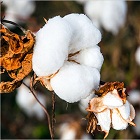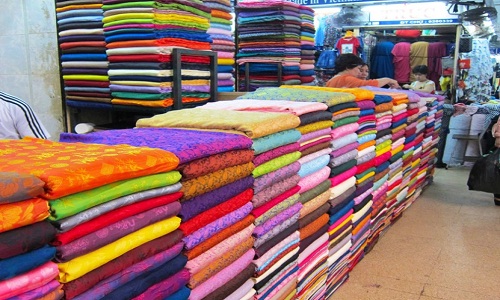FW
"Vietnam’s demand for raw cotton has seen an upsurge for six consecutive years, with August-to-January (Marketing YTD) imports at their highest levels ever. This is a positive sign for US cotton exports, as American cotton has made up about 40 per cent of Vietnam’s cotton imports over the last three years. US exports of cotton have made up about 50 per cent of Vietnam’s imports to date, suggesting even greater market share than in the past."

Vietnam’s demand for raw cotton has seen an upsurge for six consecutive years, with August-to-January (Marketing YTD) imports at their highest levels ever. This is a positive sign for US cotton exports, as American cotton has made up about 40 per cent of Vietnam’s cotton imports over the last three years. US exports of cotton have made up about 50 per cent of Vietnam’s imports to date, suggesting even greater market share than in the past.
FDIs into Vietnam

Much of Vietnam’s growth in recent years has been driven by a decline in cotton spinning in China. China’s now ended cotton price support program required that the state reserve purchase large amounts of cotton, which drove up cotton prices in China relative to global levels. Due to this uncompetitive pricing, a wave of FDI flowed into Vietnam’s spinning sector.
With ASEAN-China Free Trade Agreement, Vietnam-produced cotton yarn has duty free access to China, versus a 40 per cent above-quota duty on raw cotton imported into China. Many Chinese-owned mills relocated to Vietnam, spinning the same yarn using the same (mostly US) cotton, then shipping the yarn to China for the next stage in the value chain. About half to two-thirds of Vietnam’s cotton imports are spun in foreign-owned mills, with much of it exported to China.
Impact on the US
Given the United States’ pre-eminent position in Vietnamese cotton sector, any decline in Vietnam’s spinning would negatively impact US exports. Additionally, when US exporters were shut out of China by its initial policy moves, they were mostly able to shift to other markets, especially Vietnam, as spinning moved there. But if demand in Vietnam dried up as a result of reserve auction sales in China, there would be no new spinning transferred to markets where US cotton could compete for business. US exports would have been replaced by releases from China’s state reserves.
Factors driving Vietnam’s spinning
There are several reasons for Vietnam’s growth relative to India and Pakistan. Both India and Pakistan have faced crop shortfalls and tighter stocks in the last year, which led to comparatively high internal prices even as China’s domestic prices were becoming more competitive. Another key factor driving Vietnam’s growth may be the China-ASEAN Free Trade Agreement, which began to come into effect in 2010. With full implementation of provisions related to cotton and yarn implemented fairly rapidly, China’s customs duty on yarn imported from Vietnam, or from any ASEAN country, is zero.
Some other ASEAN countries such as Indonesia also recorded a rise in yarn exports to China, while yarn exports from major non-ASEAN countries such as Uzbekistan and South Korea saw a decline. If duty-free access for yarn is driving increased spinning in Vietnam, then the China-ASEAN Free Trade Agreement could be pushing US cotton exports higher. Yarn spinning being shifted from producer-countries like India, Pakistan, Uzbekistan, and to an extent China, into duty preferred importer countries like Vietnam bodes well for US exports. Because the China-ASEAN Free Trade Agreement does not require that raw cotton inputs be sourced within the area, US exporters are able to derive an indirect benefit from China’s duty-free ASEAN access.
Welspun India has had a 17.27 per cent decline in consolidated net profit for the third quarter ended December 31, 2016. The home textiles company had posted a net profit of Rs 181.61 crores in the same period of last financial year. Income from operations in the quarter under review was up 3.85 per cent compared to the same period last year.
The company is in the process of establishing a new supply chain system in textiles which was never there before by introducing RFID. RFID will help it track the entire supply chain. Welspun has put up a team in Egypt to source cotton and thereafter all processes from spinning to weaving and processing will be in house.
Tilt, the smart textile launched in the US market, is the company’s patented product and will be a new way of looking at textiles. In the next three or five years futuristic textiles may be the next step. As the consumer moves in smart cars and gets into smart homes, Welspun plans to bring in smart textiles to them.
Welspun aims to expand focus on branded and innovative products to become a $2 billion company in four years, with 20 per cent revenue coming in from domestic sales.
Sourcing at Magic will take place at Las Vegas Convention Center in Las Vegas from February 20 to 23, 2017. This is the largest biannual US trade show for the global retail fashion industry and supply chain, especially apparel, footwear and accessories. It is known for staying ahead of trends, while continually revamping, expanding and refining its floor offerings. This edition will unveil a new African Pavilion and a refreshed women’s fashion showcase.
The African Pavilion will feature 11 countries including Kenya, Ethiopia, Madagascar, Mauritius, Nigeria, Rwanda, South Africa, Lesotho, Ghana, Cameroon and Uganda. Additional new features will include an African-inspired fashion gallery, an African designers’ showcase and special events inside the Africa Lounge.
Another show category, WWDMAGIC, will debut with new look and feel at the upcoming event. As the largest showcase of women’s apparel and accessories in the fashion industry, the category’s new, more streamlined aesthetic will feature modern, colorful and eclectic designs and initiatives, including 8 ft. walls, inspiring signage, redesigned lounges and sleek design finishes.
Along with the redesigned show floor, new features will include a modern trend presentation, a blogger social house and a DJ lounge. Sourcing at Magic is held every February and August. It attracts thousands of attendees from more than 80 countries.
The winter 2017 edition of Texworld USA and Apparel Sourcing USA was a record-breaker, both in terms of exhibitors presented and visitor attendance. Texworld boasted over 225 exhibitors representing 12 countries, including Canada, US, Colombia, India, UK China, Hong Kong, Japan, Turkey, Korea and Taiwan. The Lenzing Pavilion had 17 exhibitors focused on integrating sustainable fibers into a wide range of product categories.
Apparel Sourcing presented 107 suppliers from nine countries including China, Hong Kong, India, Myanmar, Taiwan, USA, Sri Lanka, Mexico and Peru. The final attendance showed a 20 per cent increase over previously documented record for any winter edition in the show’s 10-year history.
Texworld USA’s educational sessions proved to be a big draw. The seminars focused on hot topics like TPP and duty-free trade, color and fabric trends, digital printing, and the impact of the buy-now-wear-now trend. The showcase placed a heavier emphasis on curating textiles across all 16 categories of products available and allowed visitors to get a wider view of exhibitor offerings for spring/summer 2018.
While buyers can visit other textile or apparel shows to network and get inspiration on trends, Texworld USA is the show to find in-demand, on-trend fabrics at realistic and affordable prices. It is an order writing show.
Denmark sees a huge opportunity in investing in Pakistan’s textile sector. The country had helped Pakistan secure GSP Plus status. Pakistan’s access to GSP Plus has substantially increased the scope for EU textiles companies to import high quality products at competitive price while Pakistani exporters have been granted duty free access to EU. So both Denmark and Pakistani companies are looking to find partnership opportunities and avail of the benefits.
Denmark is keen to expand bilateral ties with Pakistan through enhanced trade, investment, and sharing expertise mainly in the energy and textile sectors. The current trade volume between Denmark and Pakistan is around $450 million. Among Pakistan’s advantage are an abundance of raw material, socially responsible business strategies, relatively inexpensive and well-qualified labor, state-of-the-art vertically integrated textile set-ups, and design expertise.
The two countries have been enjoying historical friendship and traditional cooperation in many fields for many years but now it’s felt more efforts are needed to further strengthen ties by holding business-to-business meetings and exchange of trade delegations. Presently many Danish companies are engaged in various sectors of the economy in Pakistan.
A delegation from Pakistan visited Denmark to assess existing and potential resources, technology, knowledge and market opportunities.
Munich Fabric Start was held from January 31 to February 2, 2017. The fair communicated great energy to visitors and insiders with a series of seminars and events and a pool of innovative ideas and products. The Bluezone area -- with refreshed trend areas and booths – registered a lively attendance. The Catalyst and Keyhouse – confirming their focus on high-quality manufacturers, mostly from Europe – also attracted attention from denim and fashion insiders.
Stability, reliability and continuity again proved guarantors for Munich Fabric Start’s steady growth. A major trend the show focused on was sustainability. Jeanologia presented a selection of new products clearly focused on preserving the environment, while increasing productivity without raising costs. It has developed new jeans processing technologies that can save up to 95 per cent chemical use thanks to laser, ozone and e-flow technologies. This way rather than employing about 70 liters of water a garment – as normally required – it’s possible to use a glass of water per pair of jeans. Jeanologia has also developed interesting laser treating techniques, creating effects that are very similar to real creases, stitching, pockets and ribs.
Among other trends seen at the show were great new surface treatments. Among them were double strata denims and superfine rib corduroys.
The 6the edition of Future Fabrics Expo was held in London from January 25 to 26, 2017. The fair saw 650 visitors. This year’s edition showcased over 2,000 fashion materials with a lower environmental impact. The show featured innovative and traditional commercially viable fibers, fabrics and products that embody a range of sustainable principles and new technologies, sourced from international suppliers and mills who demonstrate a commitment to lowering environmental impact across the textile supply chain. Alongside sustainable innovative fabrics with a lower environmental footprint, low impact leathers and leather alternatives were showcased. They embody a range of sustainable principles and new technologies. It included more sustainable alternatives to the widely available conventional fabrics that currently dominate the market; helping fashion companies to begin diversifying their fabrics and materials base and lowering their environmental impact.
Future Fabrics Expo focuses on the fashion industry and how its environmental impact can be lowered through innovation in the textile industry, and novel ideas to transform the fashion system and design practice. The show also hosted seminars by organisations such as the Sustainable Apparel Coalition, Responsible Wool Standard, Textile Exchange, GOTS and suppliers such as Beyond Surface Technologies that currently are shaping the future of the textile and leather industry.
Istanbul Yarn Fair is being held February 2 to 5, 2017. This is the world’s second biggest yarn fair. It brings together the international textile industry. It hosts participants and visitors from various countries to become a sales and marketing platform that shapes the international yarn trade and textile production.
Istanbul Yarn Fair allows the formation of new distribution channels while increasing the export opportunities of the yarn industry in Turkey. As a reflection of the Turkish yarn industry, Istanbul Yarn Fair is opening up new markets in parallel with the growth trend. The fair aims to create new export and import opportunities for the industry.
The fair is the most important commercial gathering of the international yarn industry. It stands out as an opportunity not to be missed for yarn companies that want to access new markets. This event showcases products like knitted fabrics, cotton yarns, cotton blended yarns etc. in the textile, fabrics and yarns industry. It is a platform where professional visitors, buyer groups and investors from Eurasia and Africa will meet and exchange information.
Among the fabric manufacturers are those of knitted fabrics, tricot, underwear, hosiery, blankets, denims, home textile, carpets, yarns, technical and military textiles.
"The evergreen fashion icon of all seasons, denim has sustained itself in the ever expanding apparel segment. Riding on innovative experimentation with fits, colours and styles, denim has been a consumers’ delight. And R S Singh, Business Head, Blue Blends India points out the Indian denim industry will grow continuously in the years to come. “This is supported by the fact that denim is best suited for the Indian climate. There are other fabrics like polyester, viscose etc but denim is the best in the cotton segment for fashion,” he opine."

The evergreen fashion icon of all seasons, denim has sustained itself in the ever expanding apparel segment. Riding on innovative experimentation with fits, colours and styles, denim has been a consumers’ delight. And R S Singh, Business Head, Blue Blends India points out the Indian denim industry will grow continuously in the years to come. “This is supported by the fact that denim is best suited for the Indian climate. There are other fabrics like polyester, viscose etc but denim is the best in the cotton segment for fashion,” he opines. Within cotton, denim is vastly accepted, versatile and most innovative fabric. This is reason demand for denim would continue to grow. “Currently the Indian denim industry stands at 1.2 billion metre per annum. It is still growing and growing at a very fast rate. The future is not very easy to predict, but one thing is certain, there is enough growth in demand and supply both. The demand for denim products is growing anywhere between 12-15 per cent per annum. It is likely grow in the same pace,” he explains.
Tracking demand trends

Sing says denim has created space for itself by replacing existing products and this caused a dramatic growth in the sector. Especially, in the last 10-15 years, denim has gained a momentum. “If we break this 30 years’ period into two halves, growth rate was far better and faster in the second half compared to the first. In the first half, growth was not much because people were not aware about the product, technological advancement was low, and sources of information were scarce. In every respect, it was a phase of less advancement. Then the markets were also warming up to it. So, these 30 years can be summed up by describing the first half as period of consolidation and second half as period of growth,” Singh explains.
Surmounting challenges
The challenge for the industry he says is the demand-supply gap. The industry is facing oversupply issues. Demand is growing but supply has been growing more than that for the last 5-6 years. Production is constantly growing for the last 15 years. The second reason is government policies on technological upgradation and advancement, which speeded up the pace, though the demand is the primary reason for growth, growth has always been followed by demand. Demand supply gap has caused profitability issues and competition increased. But there is a bright side to competition as it helps improve practices in the industry in every respect and fosters innovation and creativity. “About a decade ago, very few mills would try to tap overseas markets, especially new ones. Because supply gap was so big that it was much more profitable to sell domestically. There was hardly any motivation to go overseas,” Singh avers.
Added to that, Singh informs, labour and pollution norms are very stringent in India. Sustainability is important but the approach is not correct. Nowadays, a person starting his business ends up spending more on following norms compared to actually putting the business together. The government can identify a space or a hub for the particular purpose, with the entire infrastructure and eco-friendly measures in place. Singh agrees feels policies are there but how effective and efficient they are is a key question. The market is still immature and is not demanding. If one offers quality, customers will ultimately come to you. “India is still at fashion infancy and we are learning by experiments,” he sums up.
Adidas Outdoor, the athletic brand for performance outdoor apparel, footwear and accessories, has announced the debut of an expanded Parley for the Oceans apparel line with performance outerwear for men and women. The line will be on display at Outdoor Retailer Snow Show 2018, to be held from January 25 to 28, 2018, in Denver, Colorado.
The brand will introduce next generation design and innovation with variations on traditional baffles for increased warmth and protection and pair unlikely textiles and styles for hybrid look. Greg Thomsen, Managing Director, Adidas Outdoor says, “The expansion to performance outerwear with Parley for the Oceans is a natural progression. The Parley styles blend well with the rest of the collection, as the lines between fashion and function continue to blur. Consumers want apparel that not only functions, but looks great. The fall/winter 2018 line looks great on a winter hike or a five-city block trek.”
Parley jackets and parkas feature recycled polyester fibre made from reclaimed ocean plastic and Climaproof, the Adidas’ proprietary waterproof breathable technology providing protection and comfort in wind, rain, or snow. Styles include the men and women’s Parley 3-Layer Jacket and Swift Parley 2-Layer; and the women’s only style, the Clima Parley Parka.
Adidas entered a partnership with Parley for the Oceans in 2015, an environmental organisation and collaboration network that raises awareness for the beauty and fragility of the oceans and implements comprehensive strategies to end plastic pollution in the ocean.
Adidas Outdoor fall/winter 2018 turns to urban fashion for design inspiration. Minimalist styling, matte fabrication and fashion colour ways are showcased in much of the collection, while hybrid combinations provide greater function and fashion-forward silhouettes.












